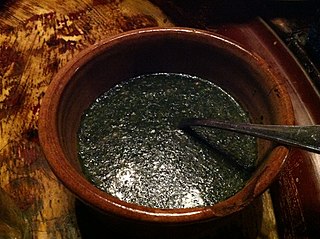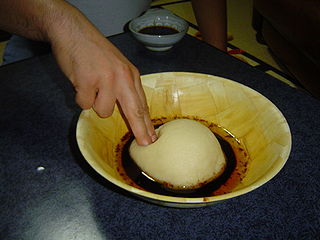Related Research Articles

Toad in the hole is a traditional English dish consisting of sausages in Yorkshire pudding batter, usually served with onion gravy and vegetables. Historically, the dish has also been prepared using other meats, such as rump steak and lamb's kidney. In the 21st century, vegetarian and vegan versions have appeared.

Tsukune (つくね、捏、捏ね) is a Japanese chicken meatball most often cooked yakitori style and sometimes covered in a sweet soy or yakitori tare, which is often mistaken for teriyaki sauce.

Peasant foods are dishes eaten by peasants, made from accessible and inexpensive ingredients.

Kibbeh is a popular dish in the Levant based on spiced ground meat and bulgur wheat. Kibbeh is considered to be a national dish of Syria and Lebanon.

Arab cuisine is the cuisine of the Arab world, defined as the various regional cuisines of the Arab people, spanning from the Maghreb to the Mashriq. These cuisines are centuries old and reflect the culture of trading in ingredients, spices, herbs, and commodities. The regions have many similarities, but also unique traditions. They have also been influenced by climate, cultivation, and mutual commerce.

Iraqi cuisine is a Middle Eastern cuisine that has its origins in the ancient Near East culture of the fertile crescent. Tablets found in ancient ruins in Iraq show recipes prepared in the temples during religious festivals—the first cookbooks in the world. Ancient Mesopotamia was home to a sophisticated and highly advanced civilization, in all fields of knowledge, including the culinary arts.

Kofta is a family of meatball or meatloaf dishes found in Balkan, Middle Eastern, North African, South Caucasian, South Asian and Central Asian cuisines. In the simplest form, koftas consist of balls of minced meat – usually beef, chicken, pork, lamb or mutton, or a mixture – mixed with spices and sometimes other ingredients. The earliest known recipes are found in early Arab cookbooks and call for ground lamb.

Mulukhiyah, also known as molokhiyya, melokhiyya, or ewedu, is a type of jute plant and a dish made from the leaves of Corchorus olitorius, commonly known in English as jute, jute leaves, jute mallow, nalta jute, or tossa jute. It is used as a vegetable and is mainly eaten in Egypt, the Levant, Sudan, Cyprus, Libya, Tunisia and Algeria. It is called saluyot in the Philippines. Mulukhiyah is rather bitter, and when boiled, the resulting liquid is a thick, highly mucilaginous broth; it is often described as "slimy", rather like cooked okra. Mulukhiyah is generally eaten cooked, not raw, and it is either eaten chopped and sautéed in oil, garlic and cilantro like in Syria or turned into a kind of soup or stew like in Egypt, typically bearing the same name as the vegetable in the local language. Traditionally mulukhiyah is cooked with chicken or at least chicken stock for flavor and is served with white rice, accompanied with lemon or lime.

Yemeni cuisine is distinct from the wider Middle Eastern cuisines, but with a degree of regional variation. Although some foreign influences are evident in some regions of the country, the Yemeni kitchen is based on similar foundations across the country.

Tharid is a bread soup that originates from Mecca, Saudi Arabia, an Arab cuisine also found in many other Arab countries. Like other bread soups, it a simple meal of broth and bread in this instance crumbled flatbread moistened with broth or stew. Historically, the flatbread used was probably stale and unleavened. As an Arab national dish it is considered strongly evocative of Arab identity during the lifetime of the Islamic prophet Muhammad. According to a widespread legend, this unremarkable and humble dish was the prophet's favorite food.
Lunch is a meal eaten around the middle of the day. It is commonly the second meal of the day, after breakfast, and varies in size by culture and region.

The cuisine of Libya is a mix of Berber, Arab and Mediterranean cuisines with Ottoman and Italian influence. One of the most popular Libyan dishes is bazin, an unleavened bread prepared with barley, water and salt. Bazin is prepared by boiling barley flour in water and then beating it to create a dough using a magraf, which is a unique stick designed for this purpose.

A meatball is ground meat (mince) rolled into a ball, sometimes along with other ingredients, such as bread crumbs, minced onion, eggs, butter, and seasoning. Meatballs are cooked by frying, baking, steaming, or braising in sauce. There are many types of meatballs using different types of meats and spices. The term is sometimes extended to meatless versions based on vegetables or fish; the latter are also commonly known as fish balls.

Bazin (Arabic: البازين, pronounced, is an unleavened bread in the cuisine of Libya prepared with barley, water and salt. Bazin is prepared by boiling barley flour in water and then beating it to create a dough using a magraf, which is a unique stick designed for this purpose. The dough may then be placed in a pan and allowed time to harden, after which it is baked or steamed. The salt contributes to the hardness of the bazin. Bazin may have a paste-like and hardened texture. It may also be prepared using whole wheat flour, olive oil and pepper as ingredients.

Stewed tomatoes is a dish made by cooking tomatoes in a stew. It is often cooked with garlic and herbs, and consumed with bread or meat. It is eaten as either a main dish or a side dish. Stewed tomatoes are sometimes prepared in the United States on occasions such as Thanksgiving.
References
- 1 2 Shahîd, I. (2010). Byzantium and the Arabs in the Sixth Century. Harvard University Press. p. 130. ISBN 978-0-88402-347-0 . Retrieved May 19, 2016.
- ↑ Mambo, Mohamed (January 25, 2013). "Tanzania: Today Is the Birthday of Prophet Muhammad". AllAfrica.com . Retrieved 19 May 2016.(subscription required)
- ↑ Strohmeier, M. (1984). Islamkundliche Untersuchungen. Islamkundliche Untersuchungen. Schwarz. p. 273. ISBN 978-3-922968-97-9 . Retrieved May 19, 2016.
- ↑ Quiles, J.L.; Ramírez-Tortosa, M.C.; Yaqoob, P. (2006). Olive Oil and Health. CAB books. CABI Pub. p. 30. ISBN 978-1-84593-068-4 . Retrieved May 19, 2016.
- ↑ Ayto, J. (2012). The Diner's Dictionary: Word Origins of Food and Drink. Oxford Quick reference collection. OUP Oxford. p. 2. ISBN 978-0-19-964024-9 . Retrieved May 19, 2016.
- ↑ Albala, K. (2007). Beans: A History. Bloomsbury Academic. p. 35. ISBN 978-1-84520-430-3 . Retrieved May 19, 2016.
- ↑ Nasrallah, N. (2007). Annals of the Caliphs' Kitchens: Ibn Sayyār al-Warrāq's Tenth-Century Baghdadi Cookbook. Islamic History and Civilization. Brill. p. 300. ISBN 978-90-474-2305-8 . Retrieved May 19, 2016.
- ↑ Salloum, H.; Salloum, M.; Elias, L.S. (2013). Sweet Delights from a Thousand and One Nights: The Story of Traditional Arab Sweets. I. B. Tauris. p. 39. ISBN 978-1-78076-464-1 . Retrieved May 19, 2016.
- 1 2 3 Vered, Ronit (July 10, 2014). "Fasting and fast-food: 30 days and 30 bites of Ramadan - Pleasure Hunting". Haaretz . Retrieved May 19, 2016.
- ↑ Davidson, A.; Jaine, T. (2014). The Oxford Companion to Food. Oxford Companions. OUP Oxford. p. 818. ISBN 978-0-19-104072-6 . Retrieved May 19, 2016.(subscription required)